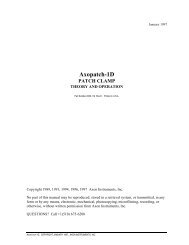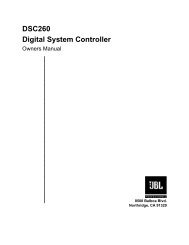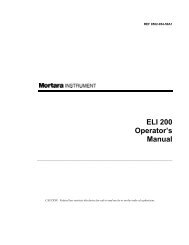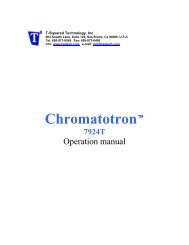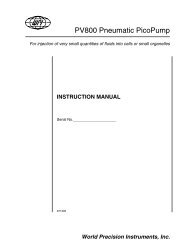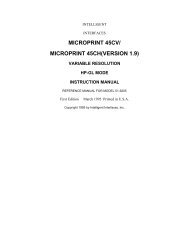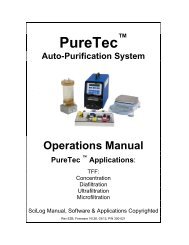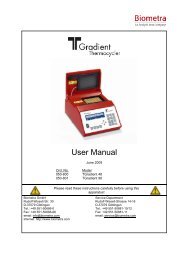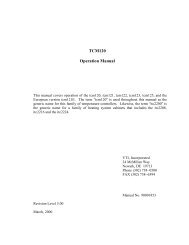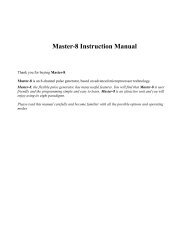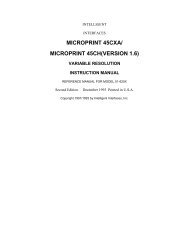Model '683' Small Animal Ventilator User's Manual
Model '683' Small Animal Ventilator User's Manual
Model '683' Small Animal Ventilator User's Manual
Create successful ePaper yourself
Turn your PDF publications into a flip-book with our unique Google optimized e-Paper software.
<strong>Model</strong> ‘683’<br />
<strong>Small</strong> <strong>Animal</strong> <strong>Ventilator</strong><br />
<strong>User's</strong> <strong>Manual</strong><br />
‘683’ <strong>Small</strong> <strong>Animal</strong> <strong>Ventilator</strong> MA1 55-3438<br />
Publication 5375-001-REV-E
WEEE/RoHS Compliance Statement<br />
EU Directives WEEE and RoHS<br />
To Our Valued Customers:<br />
We are committed to being a good corporate citizen. As part of that commitment,<br />
we strive to maintain an environmentally conscious manufacturing operation. The<br />
European Union (EU) has enacted two Directives, the first on product recycling<br />
(Waste Electrical and Electronic Equipment, WEEE) and the second limiting the use<br />
of certain substances (Restriction on the use of Hazardous Substances, RoHS).<br />
Over time, these Directives will be implemented in the national laws of each EU<br />
Member State.<br />
Once the final national regulations have been put into place, recycling will be offered<br />
for our products which are within the scope of the WEEE Directive. Products falling<br />
under the scope of the WEEE Directive available for sale after August 13, 2005 will<br />
be identified with a “wheelie bin” symbol.<br />
Two Categories of products covered by the WEEE Directive are currently exempt<br />
from the RoHS Directive – Category 8, medical devices (with the exception of<br />
implanted or infected products) and Category 9, monitoring and control instruments.<br />
Most of our products fall into either Category 8 or 9 and are currently exempt from<br />
the RoHS Directive. We will continue to monitor the application of the RoHS<br />
Directive to its products and will comply with any changes as they apply.<br />
• Do Not Dispose Product with Municipal Waste<br />
• Special Collection/Disposal Required
1<br />
H a r v a r d A p p a r a t u s M o d e l ‘ 6 8 3 ’ S m a l l A n i m a l Ve n t i l a t o r U s e r ' s M a n u a l<br />
Table of Contents<br />
SUBJECT PAGE NO.<br />
General Information - Warranty & Repairs..........2<br />
General Safety Summary ......................................3<br />
Specifications ........................................................4<br />
Description & Features..........................................5<br />
Voltage Selection ..................................................6<br />
Fuse Replacement ................................................6<br />
Pump Operation:<br />
Connecting to <strong>Animal</strong> ........................................7<br />
Selecting Rate & Volume ..................................8<br />
Setting Volume & Rate ......................................9<br />
Using Gas Mixtures............................................9<br />
Creating a PEEP................................................9<br />
Cleaning & Maintenance ....................................10<br />
Changing Piston & Cylinder ..........................11-12<br />
Publication 5375-001-REV-E
2<br />
H a r v a r d A p p a r a t u s M o d e l ‘ 6 8 3 ’ S m a l l A n i m a l Ve n t i l a t o r U s e r ' s M a n u a l<br />
General Information<br />
Serial Numbers<br />
All inquires concerning our product should refer to the serial number of the unit. Serial<br />
numbers are located on the rear of the chassis.<br />
Calibrations<br />
All electrical apparatus is calibrated at rated voltage and frequency. While the flow will stay<br />
calibrated, the peak will vary.<br />
Warranty<br />
Harvard Apparatus warranties this instrument for a period of one year from date of purchase.<br />
At its option, Harvard Apparatus will repair or replace the unit if it is found to be defective as to<br />
workmanship or material.<br />
This warranty does not extend to damage resulting from misuse, neglect or abuse, normal<br />
wear and tear, or accident.<br />
This warranty extends only to the original customer purchaser.<br />
IN NO EVENT SHALL HARVARD APPARATUS BE LIABLE FOR INCIDENTAL OR<br />
CONSEQUENTIAL DAMAGES. Some states do not allow exclusion or limitation of<br />
incidental or consequential damages so the above limitation or exclusion may not apply to<br />
you. THERE ARE NO IMPLIED WARRANTIES OF MERCHANTABILITY, OR FIT-<br />
NESS FOR A PARTICULAR USE, OR OF ANY OTHER NATURE. Some states do not<br />
allow this limitation on an implied warranty, so the above limitation may not apply to you.<br />
If a defect arises within the two-year warranty period, promptly contact Harvard Apparatus,<br />
84 October Hill Road, Building 7, Holliston, Massachusetts 01746-1371 using our toll<br />
free number 1-800-272-2775. Goods will not be accepted for return unless an RMA (returned<br />
materials authorization) number has been issued by our customer service department. The<br />
customer is responsible for shipping charges. Please allow a reasonable period of time for completion<br />
of repairs, replacement and return. If the unit is replaced, the replacement unit is covered<br />
only for the remainder of the original warranty period dating from the<br />
purchase of the original device.<br />
This warranty gives you specific rights, and you may also have other rights which vary from<br />
state to state.<br />
Repair Facilities and Parts<br />
Harvard Apparatus stocks replacement and repair parts. When ordering, please describe parts<br />
as completely as possible, preferably using our part numbers. If practical, enclose a sample or<br />
drawing. We offer a complete reconditioning service.<br />
CAUTION<br />
This ventilator is not registered with the FDA and is not for clinical use on human or veterinary<br />
patients. It is intended for research use only.<br />
Publication 5375-001-REV-E
3<br />
H a r v a r d A p p a r a t u s M o d e l ‘ 6 8 3 ’ S m a l l A n i m a l Ve n t i l a t o r U s e r ' s M a n u a l<br />
General Safety Summary<br />
Please read the following safety precautions to ensure proper use of your ventilator.<br />
To avoid potential hazards and product damage, use this product only as instructed in<br />
this manual. If the equipment is used in a manner not specified by the manufacturer,<br />
the protection provided by the equipment may be impaired.<br />
To Prevent Hazard or Injury:<br />
Use Proper Line Cord<br />
Use only the specified line cord for this product and make sure line cord is certified<br />
for country of use.<br />
Ground t he Product<br />
This product is grounded through the grounding conductor of the power cord. To<br />
avoid electric shock, the grounding conductor must be connected to earth ground.<br />
Before making any connections to the input or output terminals of the product, ensure<br />
that the product is properly grounded.<br />
Mak e Proper Connect ions<br />
Make sure all connections are made properly and securely.<br />
Orient Equipm ent Properly<br />
Do not position the equipment such that it is difficult to reach the disconnecting<br />
device.<br />
Observe all Ter m inal Rat ings<br />
Review the operating manual to learn the ratings on all connections.<br />
Use Proper Fuse<br />
Use only specified fuses with product.<br />
Avoid Ex posed Circuit r y<br />
Do not touch any electronic circuitry inside of the product.<br />
Do Not Operat e w it h Suspect ed Failures<br />
If damage is suspected on or to the product do not operate the product. Contact qualified<br />
service personnel to perform inspection.<br />
Place Product in Proper Environm ent<br />
Review the operating manual for guidelines for proper operating environments.<br />
Observe all Warning Labels on Product<br />
Read all labels on product to ensure proper usage.<br />
CAUTION<br />
Refer to <strong>Manual</strong><br />
Publication 5375-001-REV-E<br />
Protective Ground<br />
Terminal
4<br />
H a r v a r d A p p a r a t u s M o d e l ‘ 6 8 3 ’ S m a l l A n i m a l Ve n t i l a t o r U s e r ' s M a n u a l<br />
Specifications<br />
‘683’ <strong>Small</strong> <strong>Animal</strong> <strong>Ventilator</strong> Specifications<br />
Rate Adjustable from 30 to 150 strokes/min while the ventilator is running<br />
Phase Ratio 1:1 fixed<br />
Dimensions, 25 x 32.5 x 20 cm<br />
H x L x W (10 x 13 x 8 in)<br />
Weight 9.5 kg (21lbs)<br />
Power 100-20 VAC/200-230 VAC, 0.7A/0.35A max., 50/60 Hz<br />
Stroke Rate Continuously variable from 30 to 150 strokes/min while the ventilator<br />
is running, with LIGHT-EMITTING DIODE (LED) DISPLAY.<br />
Volume<br />
Environmental:<br />
Adjustable from 0.2 to 5.0 cc/stroke or 1.5 to 30.0 cc/stroke while<br />
the ventilator is running<br />
Operating Temperature 0˚C to 40˚C (32˚F to 104˚F)<br />
Operating Humidity 20% to 80% RH, non-condensing<br />
Installation Category II<br />
Pollution Degree<br />
Port:<br />
1<br />
Part Number<br />
Size<br />
5121-074<br />
ID .128" (3.25mm)<br />
OD .188" (4.78mm)<br />
Catalog No. 55-0000<br />
Accessories<br />
55-5282 Overhaul Kit for 5cc <strong>Small</strong> <strong>Animal</strong> <strong>Ventilator</strong>; contains O-rings,<br />
valve springs, lubricants, etc. to overhaul <strong>Ventilator</strong><br />
55-5283 Overhaul Kit for 30cc <strong>Small</strong> <strong>Animal</strong> <strong>Ventilator</strong>; contains O-rings,<br />
valve springs, lubricants, etc. to overhaul <strong>Ventilator</strong><br />
Publication 5375-001-REV-E
5<br />
H a r v a r d A p p a r a t u s M o d e l ‘ 6 8 3 ’ S m a l l A n i m a l Ve n t i l a t o r U s e r ' s M a n u a l<br />
Description & Features<br />
The current MODEL 683 (NEW STYLE WITH DIGITAL READOUT) is an improved<br />
volume controlled small animal/rodent respirator that is functionally identical to previous<br />
MODELS (680, 681, and 683 OLD STYLE WITHOUT DIGITAL READOUT) with the<br />
following major changes:<br />
• New, stronger motor and motor speed control with LED<br />
(light emitting diode) read-out of rate (stroke rate or breaths/min).<br />
• A new design of the vertical slide valve that has no “O”-Rings or<br />
passive check valves and requires no adjustments.<br />
NOTE: In any correspondence, please refer to the ventilator as “MODEL 683 with LED RATE<br />
READ-OUT”<br />
The MODEL 683 is a positive volume ventilator intended to meet the respiratory requirements<br />
of small laboratory animals weighing up to 5 kg (11 lb), covering rodents through rabbits.<br />
This ventilator is furnished with two interchangeable piston/cylinder assemblies of 0.2 to<br />
5.0 ml/breath (5 CC) and 1.5 to 30.0 ml/breath (30 CC). The smaller cylinder is factory<br />
installed, and the larger one is supplied separately. The mechanical design features a linkage<br />
that enables the piston to touch the end of the cylinder at each stroke regardless of the<br />
volume. This assures that all the air/gas mixture taken into the ventilator is expelled<br />
at each stroke.<br />
A positive mechanical slide valve is actuated by a cam on the motor to synchronize inspiration<br />
and expiration with the motion of the piston. Any NON-EXPLOSIVE gas/air mixture can<br />
be used with the ventilator. A three-way slide valve is attached to the mechanism plate at the<br />
end of the cylinder and actuated by a cam on the motor.<br />
These ventilators (MODELS 680, 681, 683 OLD or NEW STYLES) are NOT TO BE<br />
USED IN AN EXPLOSIVE ATMOSPHERE OR WITH ANY EXPLOSIVE GASES<br />
SUCH AS ETHER OR CYCLOPROPANE, ETC. THESE VENTILATORS ARE NOT<br />
EXPLOSION-PROOF.<br />
Publication 5375-001-REV-E
6<br />
H a r v a r d A p p a r a t u s M o d e l ‘ 6 8 3 ’ S m a l l A n i m a l Ve n t i l a t o r U s e r ' s M a n u a l<br />
Voltage Selection/Fuse Replacement<br />
Volt age Select ion<br />
1. The ‘683’ <strong>Ventilator</strong> is equipped with a 115/230V selector feature, which is incorporated<br />
into the power entry module located on the side of the unit (see figure below). The<br />
<strong>Ventilator</strong> is shipped from the factory with the voltage selector set at 115V. To change<br />
voltage from 115V to 230V, follow these steps:<br />
a. Turn off main power, and disconnect power cord.<br />
b. Using a small flathead screwdriver, pry open the fuse access door on the power<br />
entry module (see figure below).<br />
c. Remove fuse holder by using the small flathead screwdriver.<br />
d. Rotate the red fuse holder 180 deg. and install back into power entry module.<br />
e. Close small access door firmly until fully closed. In power entry module window<br />
(see detail below) 230V should be seen.<br />
f. Re-install power cord.<br />
2. Turn on main power switch located on the rear panel. The display will now illuminate.<br />
The number displayed is the current strokes per minute rate.<br />
Fuse Replacem ent<br />
Key Information<br />
1. Make sure power cord is disconnected from the main power supply before servicing the fuse.<br />
2. Use only Type 3AG, 1/4” x 1-1/4”, 0.75 amp, 250 volts; Type T (time delay) fuses<br />
(Harvard Apparatus part # 5153-554 or equivalent).<br />
Turn off power and remove power cord from power module. Use a straight blade screwdriver<br />
to pry open the access door. Remove the fuse holder and then remove the fuses from this<br />
holder as shown in the figure below. Replace fuses using only 0.75A amp, 250 volts, Type T<br />
fuses. Then replace the fuse holder.<br />
Note: A non-operator-replaceable fuse exists inside of the equipment. This fuse is rated T 40mA<br />
250V, 5 x 20mm.<br />
Publication 5375-001-REV-E
7<br />
H a r v a r d A p p a r a t u s M o d e l ‘ 6 8 3 ’ S m a l l A n i m a l Ve n t i l a t o r U s e r ' s M a n u a l<br />
Operating the Pump<br />
Connection to the <strong>Animal</strong><br />
The vertical slide valve has four ports (see figure below):<br />
• The top port is the return channel from the animal, which leaves the Pump<br />
at the port on the side. It is at this top port that expired air can be collected or recycled.<br />
• The middle port is the room air/gas channel to the animal.<br />
• The bottom port is the room air or gas mixture intake.<br />
Note: It is important that the tubes to and from the animal be as short as possible.<br />
The actual connection to the animal can be either:<br />
• Tracheal cannula<br />
• Endotracheal tube with or without a cuff<br />
A selection of trachael cannula and endotracheal tubes are listed in the Harvard Bioscience<br />
Catalog. It is important that the volume of tubing shared by inspired and expired air (dead space)<br />
be kept to a minimum by having the “Y” or “T” connector as close to the animal as possible.<br />
Publication 5375-001-REV-E
8<br />
H a r v a r d A p p a r a t u s M o d e l ‘ 6 8 3 ’ S m a l l A n i m a l Ve n t i l a t o r U s e r ' s M a n u a l<br />
Operating the Pump (Cont’d)<br />
Tidal Volume (ml Ambient Temperature)<br />
500<br />
400<br />
300<br />
200<br />
150<br />
100<br />
80<br />
60<br />
50<br />
40<br />
30<br />
20<br />
15<br />
10<br />
8<br />
6<br />
5<br />
4<br />
3<br />
2<br />
1<br />
0.8<br />
0.6<br />
0.5<br />
Selection of Rate and Volume<br />
Refer to the <strong>Ventilator</strong> Graph (above) to select the appropriate tidal volume and respiration<br />
rate as a function of animal body weight. As a rough guide an adult rat will weigh between<br />
200 and 500 grams with tidal volumes between 0.6 to 1.25 cm 3 with respiration rates between<br />
66 to 210 breaths/min.<br />
The average rate is 100 breaths/min. For most rodents the 5 cc cylinder will be adequate.<br />
Publication 5375-001-REV-E<br />
<strong>Ventilator</strong> Graph<br />
Tidal Volume vs. Weight & Rate<br />
for Laboratory Mammals in Resting State.<br />
(Apparatus dead space must be added)<br />
70 100 200 300 400 600 800 1 2 3 4 5 6 8 10 15 20 30 40<br />
500<br />
40<br />
Breaths per Minute: 10<br />
30<br />
25<br />
20<br />
15<br />
100<br />
0.4<br />
0.4<br />
70 100 200 300 400 600 800 1 2 3 4 5 6 8 10 15 20 30 40<br />
(Grams) <strong>Animal</strong> Body Weight (Kilograms)<br />
70<br />
80<br />
90<br />
60<br />
50<br />
40<br />
400<br />
300<br />
200<br />
150<br />
100<br />
80<br />
60<br />
50<br />
40<br />
30<br />
20<br />
15<br />
10<br />
8<br />
6<br />
5<br />
4<br />
3<br />
2<br />
1<br />
0.8<br />
0.6<br />
0.5
9<br />
H a r v a r d A p p a r a t u s M o d e l ‘ 6 8 3 ’ S m a l l A n i m a l Ve n t i l a t o r U s e r ' s M a n u a l<br />
Operating the Pump (Cont’d)<br />
Set t ing Volum e<br />
The volume delivered is read by observing the excursion of the O-ring, on the piston, which is<br />
closest to the valve block. This piston O-ring excursion is relative to the volume scale on the<br />
outside of the cylinder wall. Volume change is accomplished while the Pump is running by<br />
turning “volume” knob in the desired direction.<br />
Set t ing Rat e<br />
Adjust the “Rate” control until the desired rate appears on the LED display. Avoid running the<br />
Pump at rates exceeding 150 breaths/min for periods in excess of 2 hours.<br />
CAUTION - Do not over inflate the animal. A good rule of thumb is to observe the<br />
depth of respiration in the normal calm unanesthetized animal and adjust the volume<br />
to approximate this respiration depth when the animal is attached to the ventilator.<br />
Use of Gas Mix t ure<br />
It is possible to introduce non-explosive air/gas mixtures into the lower room air port.<br />
However, the source of gas mixture is usually from a tank delivering gas is at a constant rate<br />
while the Pump takes in air/gas intermittently. Some sort of buffer/expansion chamber must<br />
be provided between the tank and the Pump. Harvard Apparatus offers a connection kit (73-<br />
3076) to depressurize the gas prior to entering the ventilator. This Pump is not designed to<br />
take air/gas inputs under pressure.<br />
Creat ing a Posit ive End-Ex pirat ory Pressure (PEEP)<br />
To create a PEEP pressure when using the ventilator, simply connect a length of tubing to the<br />
“Exhaust” port and submerge the other end in a column of water. A cylinder and clip are provided<br />
on the chassis for this purpose. The depth of the end of the tubing (in cm) below the water<br />
surface will give the PEEP pressure in cmH2O.<br />
Publication 5375-001-REV-E
10<br />
H a r v a r d A p p a r a t u s M o d e l ‘ 6 8 3 ’ S m a l l A n i m a l Ve n t i l a t o r U s e r ' s M a n u a l<br />
Maintenance<br />
Cleaning<br />
To clean the exterior surfaces, use a lint-free cloth to remove loose dust. Use care to avoid<br />
scratching the clear display window. For more efficient cleaning, use a soft cloth dampened<br />
with water or an aqueous solution of 75% isopropyl alcohol.<br />
Maint enance<br />
No special maintenance is required other than periodic lubrication of the piston O-rings and the<br />
slide valve with the special non-toxic grease provided. To get to the slide valve for lubrication:<br />
1. Remove the four screws holding the valve to the 1/4" aluminum black back plate.<br />
2. Remove the screws in front that hold the cylinder and valve together.<br />
3. Lift entire valve assembly up and out of Pump.<br />
4. Pull stainless steel valve rod and spring assembly free of valve block.<br />
5. Lubricate sparingly.<br />
<strong>Model</strong> 683 Rodent Vent ilat or Replacem ent Part s<br />
Lubricat ion<br />
This <strong>Model</strong> 683 Respiration Pump is shipped with Pink Grease to lubricate piston O-rings<br />
in cylinders and the inside of the slide valve.<br />
Publication 5375-001-REV-E
11<br />
H a r v a r d A p p a r a t u s M o d e l ‘ 6 8 3 ’ S m a l l A n i m a l Ve n t i l a t o r U s e r ' s M a n u a l<br />
Changing Piston and Cylinder<br />
This Respirator Pump is furnished with a 5 cc piston and cylinder installed in the Pump. A<br />
30 cc cylinder and piston is also supplied for users that require larger tidal volumes.<br />
Note: It is extremely important when changing piston and cylinders that they<br />
be aligned to be concentric and in line with the piston shaft.<br />
The cylinder is fastened to the 4 port vertical slide valve by means of two screws located<br />
between the “room air inlet” port and the “to animal” port on the front of the slide valve.<br />
The vertical slide valve is fastened to the black 1/4" aluminum sub base by four screws located<br />
on the opposite side from the printed label. By using these six screws, two in front and<br />
four on the side, alignment adjustments are made (see below).<br />
Publication 5375-001-REV-E
12<br />
H a r v a r d A p p a r a t u s M o d e l ‘ 6 8 3 ’ S m a l l A n i m a l Ve n t i l a t o r U s e r ' s M a n u a l<br />
Changing Piston and Cylinder (Cont’d)<br />
To remove the cylinder and piston<br />
1. Set the pump volume to maximum.<br />
2. Run Pump at lowest speed and stop the Pump when the helical coupling is exposed.<br />
3. Using a 0.050 Allen wrench (provided), disconnect the white piston from the coupling,<br />
leaving the coupling on the piston shaft.<br />
4. Remove the two screws located in the front of the slide valve.<br />
5. Remove piston and cylinder.<br />
6. Be careful to save the O-ring that is recessed in the slide valve block between the screws.<br />
The O-ring provides the airtight seal between the plastic cylinder and the valve block.<br />
To install the piston and cylinder<br />
1. Pick out the new piston and cylinder.<br />
2. Using pliers, remove the piston and lubricate with the pink grease provided.<br />
3. Insert the lubricated piston in the cylinder so that the rear of the piston is flush with the<br />
rear of the cylinder with the 1/8" diameter coupling stud protruding.<br />
4. Fasten the cylinder to the valve block with the two screws, making sure the O-ring is in<br />
place. Do not tighten these two screws completely, but just enough to hold the cylinder<br />
in place.<br />
5. The object of alignment is to have the stud at the end of the piston be exactly in line<br />
with its mating hole in the helical coupling. This insures that the piston moves freely<br />
within the cylinder without undue friction.<br />
6. The two screws at the front of the valve block control left to right alignment while the<br />
four screws at the rear of the slide valve control up and down alignment. By adjustment<br />
of these 6 screws the proper alignment can be made. Remember that the screws interact<br />
with one another so the procedure may have to be repeated one or more times.<br />
7. When proper alignment is achieved, the helical coupling should be connected. If alignment<br />
is correct, the coupling should slide onto the piston stud without bending of the<br />
piston rod.<br />
Publication 5375-001-REV-E
13<br />
H a r v a r d A p p a r a t u s M o d e l ‘ 6 8 3 ’ S m a l l A n i m a l Ve n t i l a t o r U s e r ' s M a n u a l<br />
Repair Kit<br />
Repair Instructions for the 683 Respirator<br />
Publication 5375-001-REV-E
14<br />
H a r v a r d A p p a r a t u s M o d e l ‘ 6 8 3 ’ S m a l l A n i m a l Ve n t i l a t o r U s e r ' s M a n u a l<br />
Notes<br />
Publication 5375-001-REV-E
15<br />
H a r v a r d A p p a r a t u s M o d e l ‘ 6 8 3 ’ S m a l l A n i m a l Ve n t i l a t o r U s e r ' s M a n u a l<br />
Notes<br />
Publication 5375-001-REV-E
Declaration of Conformity<br />
Application of<br />
Council Directive(s): 73/23/EEC, 89/336/EEC<br />
Standard(s) to which<br />
Conformity is Declared:<br />
Safety: EN 61010-1, 2 nd Edition (2001)<br />
Emissions/Immunity: EN 61326:1997 w/ A1:1998<br />
EN 61000-4-2:1995<br />
EN 61000-4-3:1996<br />
EN 61000-4-4:1995<br />
EN 61000-4-5:1995<br />
EN 61000-4-6:1996<br />
EN 61000-4-11:1994<br />
EN 61000-3-2:2000 w/ A.14<br />
EN 61000-3-3:1995 w/ 1997<br />
Manufacturer’s Name: Harvard Apparatus<br />
Manufacturer’s Address: 84 October Hill Road<br />
Holliston, Massachusetts 01746<br />
U.S.A.<br />
Type of Equipment: <strong>Small</strong> <strong>Animal</strong> <strong>Ventilator</strong><br />
<strong>Model</strong> No.: 683<br />
I, the undersigned, hereby declare that the equipment specified above conforms<br />
to the above Directive(s) and Standard(s).<br />
EMC compliance was evaluated by Intertek/ETL Semko.<br />
Reference test report file number: Box 3091685-001<br />
Place: United States of America<br />
Date: February 2006<br />
(Signature)<br />
Beth Bauman<br />
(Full Name)<br />
VP Engineering / Operations<br />
(Position)



